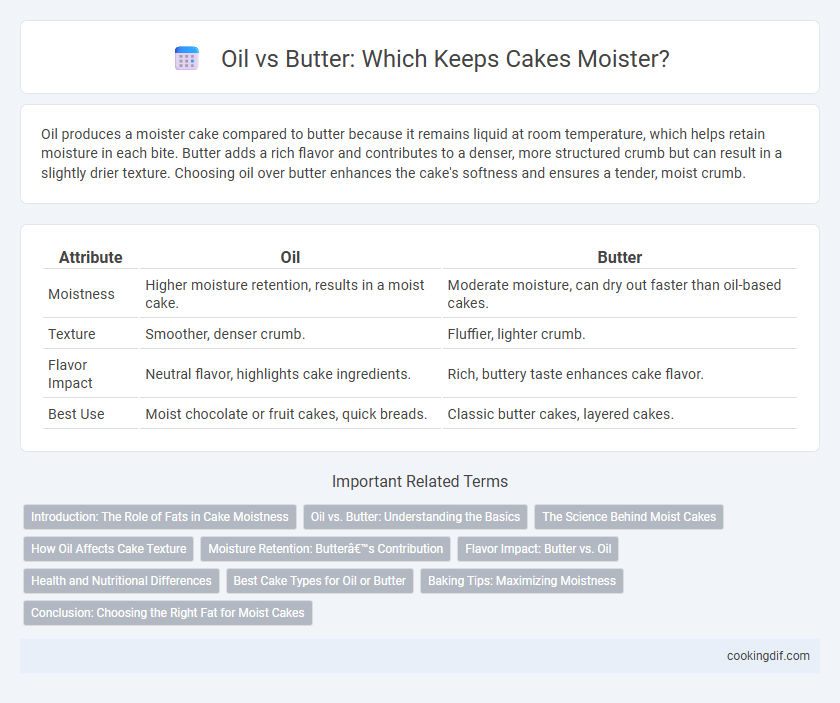Oil produces a moister cake compared to butter because it remains liquid at room temperature, which helps retain moisture in each bite. Butter adds a rich flavor and contributes to a denser, more structured crumb but can result in a slightly drier texture. Choosing oil over butter enhances the cake's softness and ensures a tender, moist crumb.
Table of Comparison
| Attribute | Oil | Butter |
|---|---|---|
| Moistness | Higher moisture retention, results in a moist cake. | Moderate moisture, can dry out faster than oil-based cakes. |
| Texture | Smoother, denser crumb. | Fluffier, lighter crumb. |
| Flavor Impact | Neutral flavor, highlights cake ingredients. | Rich, buttery taste enhances cake flavor. |
| Best Use | Moist chocolate or fruit cakes, quick breads. | Classic butter cakes, layered cakes. |
Introduction: The Role of Fats in Cake Moistness
Fats play a crucial role in cake moistness by affecting texture and crumb structure. Oil creates a consistently moist and tender cake because it remains liquid at room temperature, preventing dryness. Butter contributes rich flavor but can produce a slightly firmer texture as it solidifies when cooled, impacting moistness differently than oil.
Oil vs. Butter: Understanding the Basics
Oil creates a moister cake due to its liquid state at room temperature, which helps retain moisture more effectively than butter. Butter contributes to flavor and structure with its solid fat content, leading to a denser, richer crumb. Choosing between oil and butter depends on desired cake texture, with oil favored for light, tender cakes and butter for flavorful, firm ones.
The Science Behind Moist Cakes
Oil-based cakes retain moisture better than butter-based ones due to oil's liquid state at room temperature, which prevents the cake from drying out as it cools. Butter contains about 15-20% water, and during baking, this water evaporates, creating a firmer texture compared to oil. The triglycerides in oil create a tender crumb by coating flour proteins more effectively, reducing gluten formation and resulting in enhanced cake moistness.
How Oil Affects Cake Texture
Oil enhances cake texture by creating a tender and moist crumb due to its liquid nature, which coats flour proteins more effectively than butter, reducing gluten formation. This results in a softer, denser cake that retains moisture longer, making it a preferred choice for moist cake varieties like chiffon or pound cakes. Unlike butter, oil remains liquid at room temperature, contributing to sustained cake softness and extended shelf life.
Moisture Retention: Butter’s Contribution
Butter enhances cake moistness through its high fat content, which helps retain moisture during baking and creates a tender crumb. Its water content also steam contributes to leavening, adding to the cake's light texture while preserving soft moisture. Oil, while effective at moisture retention, lacks the emulsifying properties of butter that improve overall crumb structure.
Flavor Impact: Butter vs. Oil
Butter enhances cake flavor with a rich, creamy taste and aromatic complexity from milk solids that oil lacks. Oil contributes to a tender, moist crumb but offers a neutral flavor, allowing other ingredients to stand out. Choosing butter over oil intensifies the cake's flavor profile, adding depth and a golden color that oil cannot replicate.
Health and Nutritional Differences
Using oil in cakes generally results in a moister texture due to its liquid state at room temperature, while butter provides a richer flavor and contributes to a denser crumb. From a health perspective, oil, especially plant-based oils like olive or canola, contains more unsaturated fats, which support heart health, whereas butter has higher saturated fat levels linked to increased cholesterol. Nutritionally, butter offers fat-soluble vitamins A and D, but oil-based cakes tend to have lower saturated fat content, making them a preferable choice for those managing calorie intake or cardiovascular risk.
Best Cake Types for Oil or Butter
Oil enhances moistness in cakes like carrot cake, chocolate cake, and banana bread by retaining moisture better during baking. Butter provides rich flavor and structure ideal for pound cakes, butter cakes, and layered sponge cakes, where a tender crumb and distinct buttery taste are desired. Choosing oil favors denser, fudgier textures, while butter suits cakes that benefit from a fluffier, more aerated consistency.
Baking Tips: Maximizing Moistness
Using oil instead of butter in cake recipes increases moisture retention because oil remains liquid at room temperature, preventing the cake from drying out. Butter adds flavor and structure but can cause cakes to firm up quicker due to its solid fat content. For maximizing moistness, incorporating oil with ingredients like sour cream or yogurt enhances tenderness and keeps the crumb soft longer.
Conclusion: Choosing the Right Fat for Moist Cakes
Oil creates a moister cake by coating flour proteins and reducing gluten formation, resulting in a tender crumb, while butter imparts richer flavor and aeration but can produce a slightly drier texture. For dense, consistently moist cakes like chocolate or carrot, oil is the preferred fat choice. Butter works best in cakes where flavor and structure are prioritized, such as butter cakes or pound cakes.
Oil vs butter for cake moistness Infographic

 cookingdif.com
cookingdif.com